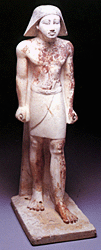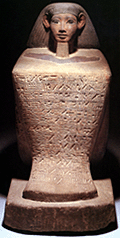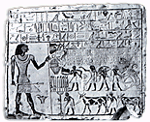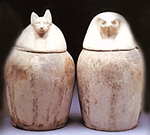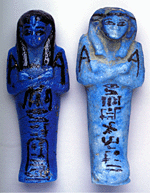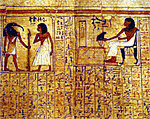
|
|
|
|
|
|
|
Gallery
Tour
FUNERARY
RELIGION The University of Pennsylvania Museum's (UPM) Egyptian collection contains many examples of tomb statues. Among these is a striding statue of a man named Khenu, who was an official of the 5th Dynasty (2500-2350 B.C.). This type of statue is called a ka statue and was placed in the tomb to serve as an embodiment of the individual's ka. The statue depicts Khenu in an idealized fashion as a robust young man. He wears a shoulder length wig and short kilt typical of Old Kingdom officials. The hieroglyphs on the base of the statue identify him by his name and title, "the sole Companion, Khenu." Block statues were very popular in ancient Egypt from the Middle Kingdom on. The name comes from their block-like shape, which may represent the official seated with his legs drawn up to his chest and covered in a long cloak. The statue to the left belonged to a man named Sitepehu, who was an overseer of priests in the area of Abydos during the reign of Queen Hatshepsut (1479-1458 B.C.). The front and proper right side of the statue are covered with lines on inscription containing funerary prayers with requests for the afterlife and listing the name, titles, and epithets of the deceased. The original color remains quite vivid on the face, hair, and hands of this statue. Material relating to funerary practices, tombs, and mastabas comes from major UPM excavation sites including Dendereh (provincial Old-Middle Kingdom cemetery), Giza (cemetery of minor officials of the Old Kingdom), Saqqara (Old Kingdom pyramid cemeteries), Meydum (Old Kingdom through Roman/Coptic periods), Abydos (Predynastic through Late Period material), Dra Abu el-Naga (New Kingdom), among others. Wealthier Egyptian officials often had memorial stelae erected near their tombs or memorial chapels. These stelae generally listed the name, titles, and epithets of the deceased together with a funerary prayer and scenes of offerings. Often other family members such as wives and children were shown accompanying the stelae owner. The stele shown to the left belonged to a man named Nefersefekhy, who was an official and priest in the town on Thinis. The somewhat primitive style of the stele is typical of provincial art of the First Intermediate Period (ca. 2175 B.C.). The ancient Egyptians believed that preservation of the body after death was very important. Mummification was practiced throughout most of Egyptian history. It was a long process that may have taken up to 70 days after death. The internal organs (except the heart) were removed and the body was placed in a salt-like substance called natron until it was desiccated. It was then removed, cleaned, anointed with oils and spices, and wrapped in strips of linens bandages. Distributed throughout the wrappings were scarabs and other amulets believed to facilitate the individual's entrance to the afterlife. The internal organs that had been removed from the body were preserved in canopic jars. The deceased was then placed in a coffin (or series of coffins) and buried in a well-prepared tomb along with possessions he or she would need in the afterlife. The coffin and mummy shown to the left belong to a man named Djed-Hapy, who lived during the Third Intermediate Period (1075-656 B.C.). His coffin is made of brightly painted wood with scenes of a mummy lying on a funeral bed attended by a series of gods and goddesses. The front of the coffin is also decorated with five lines of text containing a funerary prayer identifying Djed-Hapy as the son of Petosiris (his father) and Setmuthepet (his mother). His mummy is wrapped with 22 layers of linen and is decorated with panels of painted cartonnage (a form of smooth plaster) and a gilded cartonnage mummy mask. Modern medical techniques such as x-rays, CAT scans, and DNA testing are now being used to learn more about the health patterns of the ancient Egyptians. From x-rays of Djed-Hapy, we know that he was a man in his 50's who suffered from scoliosis and a degenerative disease of his hip joints. The use of x-rays allows Egyptologists to see what is inside the many layers of linen bandages without unwrapping the mummy and destroying the wrappings in the process. Sets of four jars known as canopic jars were used to hold the internal organs of the deceased after they had been removed from the body during the mummification process. The earliest canopic jars were plain. In the early New Kingdom, they were topped with four identical representations of the deceased. Finally the jars came to be decorated with the heads of four deities, representing the four sons of Horus, each of whom protected a different internal organ. The human-headed Imsety guarded the liver and was associated with the goddess Isis. The jackal-headed god, Duamutef, watched over the stomach together with the goddess Neith. Qebehsenuef is the falcon-headed god who protected the intestines; Selket was his partner in protection. Finally, the baboon-headed god Hapy guarded the lungs with the aid of the goddess Nepthys. Beginning in the New Kingdom, small human-shaped figurines called shabtis were placed in Egyptian tombs as a common part of the burial equipment. It was believed that the shabti would magically come to life and perform any agricultural or manual labor that the deceased might by required to do in the afterlife. For this reason, shabtis are shown carrying agricultural tools like picks and hoes and can even have small baskets on their backs. The shabti figurines are often inscribed with a spell from the Book of the Dead that described the work of the shabtis and their willingness to complete the task on behalf of the deceased. The Book of the Dead of Neferrenpet, made of papyrus, contains spells that are known collectively by the modern name the Book of the Dead and are derived from the earlier Middle Kingdom Coffin Texts and Old Kingdom Pyramid Texts. These funerary texts were a necessary part of the funerary equipment of the ancient Egyptians. The Book of the Dead dates to the New Kingdom or later and consists of prayers, invocations, and magical texts to ensure the survival of the deceased in the afterlife. The vignettes of religious scenes relate specifically to the accompanying religious texts. This copy belonged to a man named Neferrenpet, who was a royal necropolis worker in the town of Deir el Medina during the reign of Ramses II (1290-1224 B.C.). |
|
[top] |
|
|
|
|
|
|
Egypt
Home |
Expeditions Past and Present | Gallery
Tour | Gods and Goddesses |
